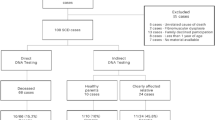Abstract
Postmortem genetic testing is a diagnostic tool that is becoming increasingly utilized. The benefits and limitations of genetic testing in cases of sudden, unexpected death in the young (≤ 40 years old) are reviewed from the perspective of the Office of Chief Medical Examiner of the City of New York, whose Molecular Genetics Laboratory, accredited by College of American Pathologists, has had 15 years of postmortem testing experience. Challenges to the interpretation and communication of testing results are highlighted, and opportunities for improving testing yield are discussed for age groups across the lifespan, from infancy to adulthood.
Similar content being viewed by others
References
Wang D, Shah KR, Um SY, et al. Cardiac channelopathy testing in 274 ethnically diverse sudden unexplained deaths. Forensic Sci Int. 2014;237:90–9.
Lin Y, Williams N, Wang D, et al. Applying high-resolution variant classification to cardiac arrhythmogenic gene testing in a demographically diverse cohort of sudden unexplained deaths. Circ Cardiovasc Genet. 2017;10(6). https://doi.org/10.1161/CIRCGENETICS.117.001839
Duncan JR, Paterson DS, Hoffman JM, et al. Brainstem serotonergic deficiency in sudden infant death syndrome. JAMA. 2010;303:430–7.
Haynes RL, Frelinger AL 3rd, Giles EK, et al. High serum serotonin in sudden infant death syndrome. Proc Natl Acad Sci U S A. 2017;114:7695–700.
Sadeh D, Shannon DC, Abboud S, Saul JP, Akselrod S, Cohen RJ. Altered cardiac repolarization in some victims of sudden infant death syndrome. N Engl J Med. 1987;317:1501–5.
Perticone F, Ceravolo R, Maio R, Cosco C, Mattioli PL. Heart rate variability and sudden infant death syndrome. Pacing Clin Electrophysiol. 1990;13:2096–9.
Schwartz PJ, Stramba-Badiale M, Segantini A, et al. Prolongation of the QT interval and the sudden infant death syndrome. N Engl J Med. 1998;338:1709–14.
Neyroud N, Tesson F, Denjoy I, et al. A novel mutation in the potassium channel gene KVLQT1 causes the Jervell and Lange-Nielsen cardioauditory syndrome. Nat Genet. 1997;15:186–9.
Gando I, Morganstein J, Jana K, McDonald TV, Tang Y, Coetzee WA. Infant sudden death: Mutations responsible for impaired Nav1.5 channel trafficking and function. Pacing Clin Electrophysiol. 2017;40:703–12.
Tester DJ, Wong LCH, Chanana P, et al. Exome-wide rare variant analyses in sudden infant death syndrome. J Pediatr. 2018;203:423–8 e11.
Mates J, Mademont-Soler I, Del Olmo B, et al. Role of copy number variants in sudden cardiac death and related diseases: genetic analysis and translation into clinical practice. Eur J Hum Genet. 2018;26:1014–25.
Yoshinaga M, Kucho Y, Ushinohama H, Ishikawa Y, Ohno S, Ogata H. Autonomic function and QT interval during night-time sleep in infant long QT syndrome. Circ J. 2018;82:2152–9.
Weintraub RG, Gow RM, Wilkinson JL. The congenital long QT syndromes in childhood. J Am Coll Cardiol. 1990;16:674–80.
Georgievskaya Z, Tang Y, Williams N, Sampson B, Gelb BD, Kontorovich AR. Fatal myocarditis is associated with rare cardiomyopathy gene variants. Circulation. 2018;136:A18206.
Tang Y, Sampson B, Pack S, et al. Ethnic differences in out-of-hospital fatal pulmonary embolism. Circulation. 2011;123:2219–25.
Halvorsen M, Lin Y, Sampson BA, et al. Whole exome sequencing reveals severe thrombophilia in acute unprovoked idiopathic fatal pulmonary embolism. EBioMedicine. 2017;17:95–100.
Gago-Diaz M, Ramos-Luis E, Zoppis S, et al. Postmortem genetic testing should be recommended in sudden cardiac death cases due to thoracic aortic dissection. Int J Legal Med. 2017;131:1211–9.
Chen J, Weber M, Um SY, Walsh CA, Tang Y, McDonald TV. A dual mechanism for I (Ks) current reduction by the pathogenic mutation KCNQ1-S277L. Pacing Clin Electrophysiol. 2011;34:1652–64.
Gerull B, Heuser A, Wichter T, et al. Mutations in the desmosomal protein plakophilin-2 are common in arrhythmogenic right ventricular cardiomyopathy. Nat Genet. 2004;36:1162–4.
Williams N, Marion R, McDonald TV, et al. Phenotypic variations in carriers of predicted protein-truncating genetic variants in MYBPC3: an autopsy-based case series. Cardiovasc Pathol. 2018;37:30–3.
Sampson BA, Tang Y. Holistic approach to determine cause of autopsy-negative sudden natural death. J Am Coll Cardiol. 2017;69:2146–8.
Funding
Grant awards (2015-DN-BX-K017 and 2014-DN-BX-K001) by National Institute of Justice, Office of Justice Programs, U.S. Department of Justice.
Author information
Authors and Affiliations
Corresponding author
Ethics declarations
Review article (no identifiable information is used).
Conflict of interest
None.
Ethical approval
Office of Chief Medical Examiner of the City of New York approved this work.
Informed consent
Review article (no identifiable information is used).
Rights and permissions
About this article
Cite this article
Tang, Y., Williams, N. & Sampson, B.A. Genetic testing in sudden unexpected natural death in the young: New York City Office of Chief Medical Examiner’s experience and perspective. Forensic Sci Med Pathol 15, 481–484 (2019). https://doi.org/10.1007/s12024-018-0068-6
Accepted:
Published:
Issue Date:
DOI: https://doi.org/10.1007/s12024-018-0068-6




